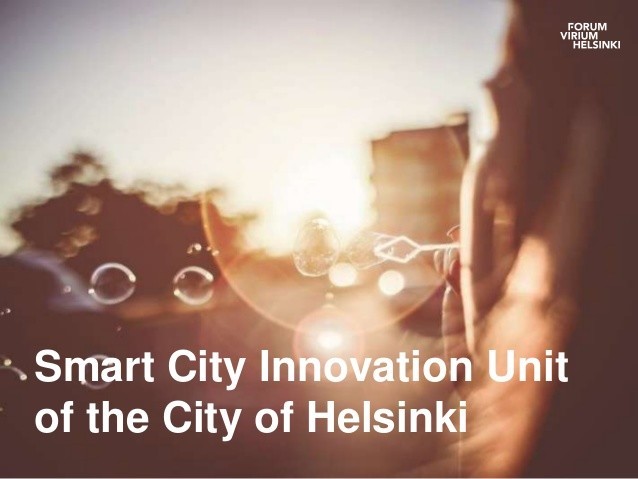Geeky Govtech Learnings from Helsinki: An Agile Approach to Smart City Development
Written by: Leah Hanvey
A few weeks ago, while I was visiting Helsinki, Finland on vacation, I attended a tech meet-up where I had the pleasure of meeting Juhani Kantola, CIO of Forum Virium Helsinki. With no previous knowledge of what the organization was or did, Juhani educated me on the somewhat unconventional structure of the organization: a completely independent organization that is housed in the City of Helsinki and funded by public agencies.
Naturally, I was intrigued as it was unlike anything I had heard of being attempted in North America, at least to my knowledge. When I asked why they took this approach, Juhani simply explained that municipal or regional governments naturally do not have the DNA to develop, procure, and deploy smart city technology effectively. Therefore, if Helsinki was going to truly become a smart city, the government decided that they, with input from their stakeholders, must design a completely new entity, one that operates alongside the City itself so to remain grounded in delivering outcomes for the public good but also one that is completely independent so not inhibit its ability to work with, adopt, procure, and develop smart city innovation and technology. Essentially, it is an organization that is directed by its mission to make residents’ lives better through technology with the culture and people of a startup: risk-friendly, experimental, and agile.
“Our development projects are based on the same principle: we solve public sector problems, but the solutions are often developed by private companies and residents,” – Forum Virium Helsinki
Forum Virium Helsinki, referred to as the development unit of the City of Helsinki, is staffed by developers and entrepreneurs and it receives funding from the European Union which is channeled swiftly into small, mission-oriented pilots. The pilots are well scoped around specific issues or problems (for example: some of their recent innovation calls include the development of an operations system for an autonomous last mile public transport solution in cities and a smart mobility solution specifically for residents and commuters in Jätkäsaari pilot area) and then the request for a pilot immediately engages private companies, academia, and citizens.

Speaking as a North American, everything that Juhani was saying in the moment made complete sense. But the fact we, in any jurisdiction in Canada or the United States, do not approach smart city development in the same way in hindsight was pretty flooring. Because of our work at UrbanLogiq, we hear all the time from governments in Europe and North America alike who are grappling with the same problem:
How can we unlock the benefits of smart city for our communities despite our aversion to risk and proclivity to bureaucracy?
The key difference is that the City of Helsinki has proactively adapted and by doing so, rejected the all of baggage associated with the second half of that question.
Instead of ramming innovation and technology adoption through incompatible bureaucratic processes and forcing it down the throats of public servants who, often rightly so, are not professional risk takers, the City of Helsinki recognized and embraced the fact that they, a government entity, are not best positioned to provide their residents with technology-derived public outcomes. So, they created a new organization to manage and lead the change necessary to squeeze all of the public good out of every commercialized disruptive technology and to set out to make Helsinki the most functional smart city in the world.
How does Forum Virium Helsinki execute this mission? It can be summed up in one word: agility. The Forum Virium Helsinki also refers to it as “user-driven innovation” or “culture of experimentation.”
To incite rapid and mission-driven technology adoption within government, Forum Virium Helsinki has applied the same principles of agile software development to smart city development. “You build the first version quickly; launch it and see what kind of feedback you get. This method should be embraced throughout the public sector,” Mika Malin, Director of Forum Virium Helsinki via the Forum Virium Helsinki website.
“The agile pilot culture is suitable for a vast range of projects and experiments. The agile development methods, common in the IT projects, work for the public sector and other aspects of city development, too,” according to their website.
Bottomline: the philosophy of agile software development that the Forum Virium Helsinki is applying to smart cities is an approach that should be increasingly considered by North American cities looking to become… well… smarter.
For more information, visit Forum Virium Helsinki’s website. Below is a helpful list of the three ways that cities procure smart city technologies, according to the organization, with commentary from the organization’s Director Mika Malin. Which method does your city use? Does your city have a similar organization as Forum Virium Helsinki? I’d love to hear about it. Please write me with your thoughts and comments: leah@urbanlogiq.com.
1. Each city buys its own systems.
“It’s expensive and inefficient. This is how things are done today, but it is a short-term solution.”
2. Large companies produce service platforms and sell them to cities one by one.
“This is okay. When a large company sells a product to a hundred different places, as the 101st buyer the city will already get a fairly good product. The downside is that these are closed source solutions.”
3. A group of cities and companies collaborate in building an open source service platform, on top of which different stakeholders can develop their own services.
“The great thing about using open source code is that it enables changing service providers, it lowers costs and allows small- and medium-sized companies get involved in public IT service development.”
Source: https://forumvirium.fi/en/



